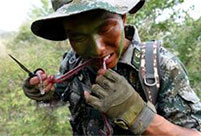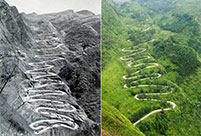

LHASA, July 20 -- Tibetan lamas and devout Buddhists staged religious dances on Monday to mark the traditional Dharma Wheel Festival and pray for peace and prosperity.
The Phagmu Monastery in Lhasa's Dagze County was crowded with people at daybreak, though grand religious dancing, known as "Chams" in Tibetan, began at 11 a.m.
"The ritual marks Buddha Sakyamuni's turning of the Dharma wheel, or wheel of law, in India on the fourth day of the sixth month in the Tibetan calendar," said Ngawang Munam, a monk at the monastery.
The celebrations included dancing, unveiling of thangka paintings and chanting of sutras, he said.
Four monks, wearing hats decorated with peacock plumes and dressed as gods, danced to the beating of drums and gongs at 11 a.m. as the audience applauded.
The dancers were served black tea from time to time, a gesture of prayer for health and harvest.
At midday, 13 conjurers appeared on the stage, wearing dark, wide-sleeved robes. Holding weapons in their hands and with bows and arrows hidden in their sleeves, the conjurers performed a mysterious dance to "expel demons".
They were followed by more monks, who wore yellow and green masks, or danced barefooted to the beatings of the gong. They danced in circles and in lines, their colorful robes glittering in the sun.
The star of the Chams, Goddess Bandain Lhamo, appeared in a black mask at 1:30 p.m., bringing the celebrations to a climax. The cheerful crowd of Buddhists worshipped her and presented hadas, which soon piled up on her neck.
"My family watches the Chams every year, to pray for good luck and enjoy traditional Tibetan culture," said Tsering Zhoigar, 60.
The Phagmu Monastery was first built in 1158 by a high monk of the Kagyupa, or the "white hat sect of Tibetan Buddhism". It was rebuilt in the 14th century and renovated into a monastery of the Gelugpa, also known as the "yellow hat sect".
 Soldiers serving at Liaoning aircraft carrier
Soldiers serving at Liaoning aircraft carrier Bikini beauties lifeguards in river rafting place
Bikini beauties lifeguards in river rafting place PLA soldiers eat raw snake meat in harsh training
PLA soldiers eat raw snake meat in harsh training Doctors use 3D-printed skull to save girl
Doctors use 3D-printed skull to save girl Kiss contest held in Nanning, SW China
Kiss contest held in Nanning, SW China Yunnan-Myanmar Road: The past and present
Yunnan-Myanmar Road: The past and present Campus belle of Xiamen University gets popular online
Campus belle of Xiamen University gets popular online Who says moms cannot be trendy and hot?
Who says moms cannot be trendy and hot? Eight fruits that defend men's health
Eight fruits that defend men's health  Saffron-collar workers - a Buddhist break
Saffron-collar workers - a Buddhist break One-China should transcend Taiwan politics
One-China should transcend Taiwan politics Celebrity geeks: the worship of China’s top gaokao scorers
Celebrity geeks: the worship of China’s top gaokao scorers Higher state of being: Women practice yoga at 2,000 meters
Higher state of being: Women practice yoga at 2,000 meters Day|Week